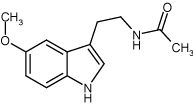Replaces Prod. #: ALX-550-071
Endogenous agonist at melatonin MT1 and MT2 receptors. Displays antioxidant and antiapoptotic effects in numerous cell types as well as beneficial effects in various neurodegenerative diseases. It protects neuronal cells from amyloid beta-mediated oxidative damage and increases survival in an Alzheimer’s disease transgenic mouse model. Melatonin directly inhibits mitochondrial permeability transition pore (IC50 = 0.8M) and reduced the loss of neurons in a rat model of transient brain ischemia.
Product Details
| Alternative Name: | N-Acetyl-5-methoxytryptamine |
| |
| Formula: | C13H16N2O2 |
| |
| MW: | 232.3 |
| |
| CAS: | 73-31-4 |
| |
| MI: | 14: 5816 |
| |
| RTECS: | AC5955000 |
| |
| Purity: | ≥98% (HPLC) |
| |
| Appearance: | White to off-white powder. |
| |
| Solubility: | Soluble in dilute aqueous acid, methanol or 100% ethanol. |
| |
| Shipping: | Ambient Temperature |
| |
| Long Term Storage: | -20°C |
| |
| Handling: | Protect from light. |
| |
| Regulatory Status: | RUO - Research Use Only |
| |
Please mouse over
Product Literature References
Melatonin and nitric oxide: S. Aydogan, et al.; J. Endocrinol. Invest.
29, 281 (2006), (Review),
Abstract;
Melatonin inhibits endothelial nitric oxide production in vitro: E.K. Tamura, et al.; J. Pineal. Res.
41, 267 (2006),
Abstract;
Melatonin suppresses macrophage cyclooxygenase-2 and inducible nitric oxide synthase expression by inhibiting p52 acetylation and binding: W.G. Deng, et al.; Blood
108, 518 (2006),
Abstract;
Direct inhibition of the mitochondrial permeability transition pore: a possible mechanism responsible for anti-apoptotic effects of melatonin: S.A. Andrabi, et al.; FASEB J.
18, 869 (2004),
Abstract;
Melatonin increases survival and inhibits oxidative and amyloid pathology in a transgenic model of Alzheimer’s disease: E. Matsubara, et al.; J. Neurochem.
85, 1101 (2003),
Abstract;
Melatonin protects against ischemia-reperfusion injury and inhibits apoptosis in isolated working rat heart: P. Dobsak, et al.; Patophysiology
9, 179 (2003),
Abstract;
Mitochondrial regulation by melatonin and its metabolites: D. Acuna-Castroviejo, et al.; Adv. Exp. Med. Biol.
527, 549 (2003), (Review),
Abstract;
Melatonin suppresses NO-induced apoptosis via induction of Bcl-2 expression in PGT-beta immortalized pineal cells: Y.M. Yoo, et al.; J. Pineal. Res.
33, 146 (2002),
Abstract;
Nitrosation of melatonin by nitric oxide and peroxynitrite: B. Blanchard, et al.; J. Pineal. Res.
29, 184 (2000),
Abstract;
Interactions between melatonin, reactive oxygen species, and nitric oxide: D.K. Lahiri & C. Ghosh; Ann. N. Y. Acad. Sci.
893, 325 (1999),
Abstract;
Melatonin as a pharmacological agent against neuronal loss in experimental models of Huntington’s disease, Alzheimer’s disease and parkinsonism: R.J. Reiter, et al.; Ann. N.Y. Acad. Sci.
890, 471 (1999),
Abstract;
The oxidant/antioxidant network: role of melatonin: R.J. Reiter, et al.; Biol. Signals Recept.
8, 56 (1999), (Review),
Abstract;
Melatonin inhibits expression of the inducible isoform of nitric oxide synthase in murine macrophages: role of inhibition of NFkappaB activation: E. Gilad, et al.; FASEB J.
12, 685 (1998),
Abstract;
Full Text
Oxidative damage in the central nervous system: protection by melatonin: R.J. Reiter; Prog. Neurobiol.
56, 359 (1998),
Abstract;
Inhibition of cerebellar nitric oxide synthase and cyclic GMP production by melatonin via complex formation with calmodulin: D. Pozo, et al.; J. Cell Biochem.
65, 430 (1997),
Abstract;
Melatonin is a scavenger of peroxynitrite: E. Gilad, et al.; Life Sci.
60, PL169 (1997),
Abstract;
Melatonin receptors step into the light: cloning and classification of subtypes: S.M. Reppert, et al.; TIPS
17, 100 (1996), (Review),
Abstract;
Melatonin comes of age?: R.M. Hagan & N.R. Oakley; TIPS
16, 81 (1995), (Review),
Abstract;
Melatonin madness: S.M. Reppert & D.R. Weaver; Cell
83, 1059 (1995), (Minireview),
Abstract;
Melatonin receptors: are there multiple subtypes?: M.L. Dubocovich; TIPS
16, 50 (1995), (Review),
Abstract;
Physiological concentrations of melatonin inhibit nitric oxide synthase in rat cerebellum: D. Pozo, et al.; Life Sci.
55, PL455 (1994),
Abstract;












